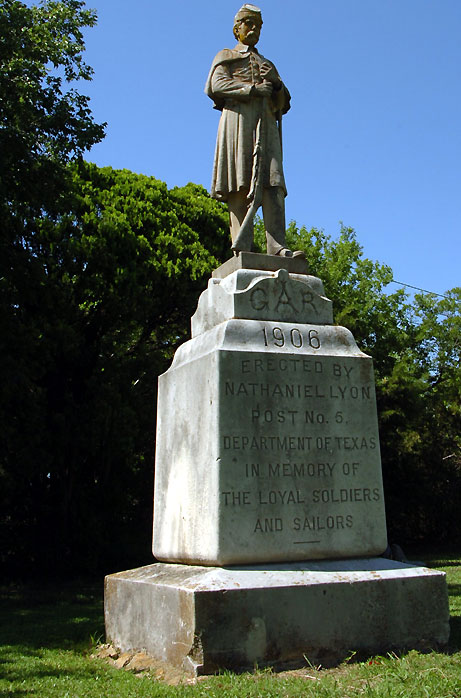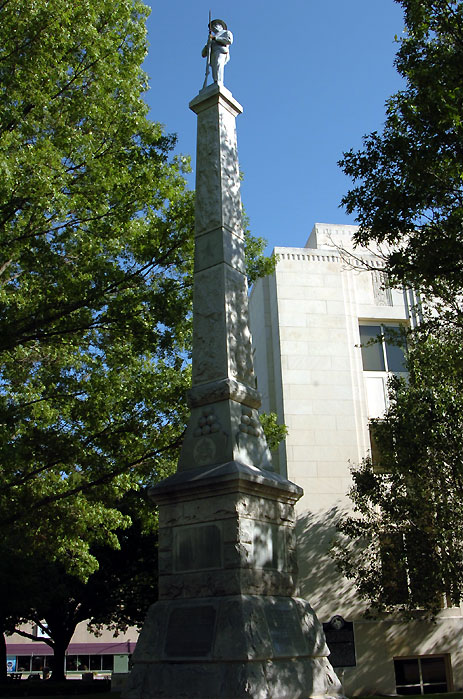DENTON (UNT), Texas — In 1935, New Braunfels businessman Ernest Clousnitzer purchased a white marble statue of a Civil War-era soldier, standing at ease with a rifle in his hand, from the city of Jacksonville after the East Texas town ordered it, but was unable to pay for it.
Decades later, many members of the Sons of Confederate Veterans may have assumed the statue honored only Confederate soldiers, since they called the figure “Johnny Rebel.” The monument, however, had been dedicated to the memory of all fallen soldiers between 1861-65 — not surprising considering that New Braunfels citizens fought on both sides of the Civil War, according to Dr. Kelly McMichael of the University of North Texas.
The New Braunfels monument, located on the city’s town square, is one of 68 large-scale Civil War monuments that McMichael features in her new book, Sacred Memories: The Civil War Monument Movement in Texas. The book takes readers on a tour on large-scale Civil War monuments — mostly, figures of soldiers, arches or slabs in granite, marble or bronze — in Texas, and tells the reasons why they were erected.
McMichael, who is the associate director of UNT’s Center for Learning Enhancement, Assessment, and Redesign, began researching Civil War memorials as a doctoral student in UNT’s Department of History. She wrote her dissertation of how Texans remembered the Civil War and included information on the memorials in one chapter.
She was surprised to learn that large-scale monuments stand in cemeteries, courthouse lawns and public parks in all regions of Texas — the Panhandle and South Texas as well as the more southern Central, East, North and North Central Texas, which had cotton plantations.
“The monuments were erected wherever a concentration of Civil War veterans lived,” McMichael said, adding that many appeared during the City Beautiful movement of the 1890s and early 20th century.
“Proponents of the movement believed that by making the physical landscapes of their cities beautiful, they could emphasize or instruct citizens in specific civic virtues and values. The erection of monuments proved one of the easiest means of combining these themes: beautification, civic lessons and social cohesion,” she said.
Members of the United Daughters of the Confederacy were primarily responsible for lobbying for the monuments in their communities, raising money to create them through elaborate fundraisers and planning celebrations for the monuments’ dedications. In doing this, they were able to gain independence through a form of work, and a prominent place in their communities, McMichael said.
“At the very public dedication ceremonies, women were often the speakers,” she said. “Women may have had different ideas about the reason for erecting the monuments — to beautify their communities and remember the fallen soldiers — than the men did. Men enjoyed the monument ceremonies because it was an economic boom for the town. People would come and spend money, and a lot of newspapers would play up the money aspect in advertising the ceremonies.”
These monument dedications, she said, were often as elaborate as the one for Dallas’ monument of a Confederate soldier atop a 60-foot-tall column, flanked by four smaller columns topped by Confederate leaders. When this monument was dedicated in City Park in 1897, the festivities for the weekend included a fancy-dress ball, a large feast in honor of Confederate veterans and, according to the Dallas Morning News, the longest, “most inspiring” parade in the city’s history.
The monument was later moved from City Park to the grounds of the Convention Center.
McMichael noted that although the majority of Texas’ large-scale Civil War memorials are to the Confederacy, three provide a Unionist interpretation of the war’s meaning. In addition to the New Braunfels monument, they include Denison’s granite figure of a Union soldier, which remembers Union soldiers who settled in anti-secession Grayson County after the war, and the Treue Der Union granite obelisk in Comfort. A group of German immigrants from Comfort who were loyal to the Union tried to flee to Mexico to avoid being drafted by the Confederate Army, but were surprised by Confederate soldiers and fought with them in an 1862 battle in nearby Kinney County.

In recent years, McMichael said, controversy has surrounded many of Texas’ Confederate memorials, with civil rights activists claiming that they glorify an army that fought to keep slavery.
But, she said, these monuments should be thought of as public art with changing messages.
“They may have stood for segregation and racial inequality at some point, but their meaning can change to what the U.S. has achieved in civil rights since the monument was dedicated. To do that, communities may need to have rededication ceremonies so the public message can be altered,” she said.

photos by Allen Rich